Now that I’m almost caught up in the vegetable gardens for spring, I thought I’d take a moment to update on the progress of the new native garden plan.
Part of the delay in updating on the garden is that this project has now turned into revamping three separate garden beds in front of the house.
This first necessitated the removal of some very stubborn, invasive Heavenly Bamboo (Nandina domestica), along with some rather ill behaved Spanish Lavender (Lavandula stoechas) that lately has been running amok all over the driveway, and even out as far as the orchard. Yet another legacy of the previous owners.

There's nothing 'Heavenly' about removing this plant. Its roots are vast, and there were runners, and small plants scattered all over this bed.
I’m happy to say, with the help of the tractor, this is now a Nandina free zone! With these thugs removed from the beds, I went back to clearing the main garden bed directly in front of the house.
In the last post, it was just starting to rain just as I was excavating deep enough to set the water feature basin that would sit under the new fountain.
The next challenge was hoisting the massive fountain rock into position. With some perseverance though, we finally managed to get it in position.
To avoid an overly austere, and square looking feature in the garden, I chose to extend a pond liner in front of the basin, and cover the liner with additional Lodi Stone, and some mid-sized river rocks.
I dug out a somewhat basin like trench before setting the pond liner in position. I hoped this would help to make it more visually interesting. In the winter months, this shallow basin next to the fountain should help to catch any overflow during heavy rains, sending water into the gravel wash around the fountain. In a sense, it will become a seasonal small pond area, that will dry out, much like a dry creek bed, in late spring through fall.
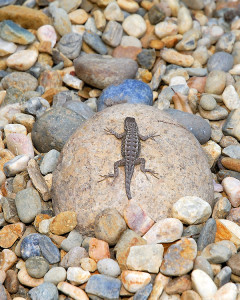
The gravel and river rocks retain heat during warm sunny afternoons, and it took no time for the lizards to notice that!
If all goes well, our resident frogs might appreciate the extra water in winter and early spring, and there’s no question the lizards are enjoying the warmth of the stones now the bulk of our rains have passed.

The lizards really approve of this new feature in the garden, although some are very well camouflaged!
With the fountain in position, it was time to plant, but before digging any holes, we first removed the window boxes from the front of the house. As much as I like the look of a window box, if they’re not constructed and installed properly they can do a tremendous amount of damage to a house.
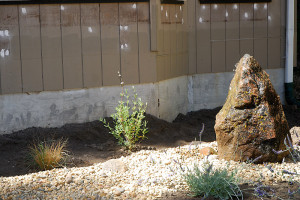
The window boxes were removed, and some minor repairs to the siding were made before we started planting
The window boxes were just wood, and once the boxes were removed it was obvious that the siding underneath was starting to rot. It’s made the facade somewhat more plain, but I’m honestly glad they’re gone before they did any more damage. Of course, that meant a little spackle and paint to spruce things up before I could get to digging.
As I’m now planting out three garden beds, rather than just one, my goal is to tie all the beds together with some of the same varieties of Salvia, Arctostaphylos, and Ceanothus, and to keep the same general color scheme throughout.

Salvia 'Pozo Blue', part of the original garden plan, will also be planted throughout the rest of the garden
One of the most challenging parts of this project was actually sourcing the plants though. Mid-spring is not an ideal time to be planting California natives. Ideally, I’d be planting in October, not May, so the plants can become established during our rainy season. Any plants that are set out in the garden this time of year will need a little extra TLC, as they’re trying to establish roots as we’re entering into our dry season.
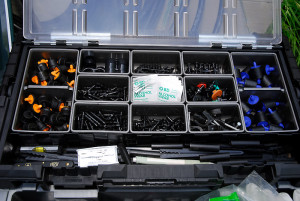
To ensure the plants have sufficient water through their first summer, we installed some temporary irrigation
Even plants that may need no irrigation once established, like our Sticky Monkeyflower, will need to be occasionally watered this first summer in the garden.

The plants, like this sticky monkeyflower (Mimulus aurantiacus), will need some supplemental irrigation while they get established
The color palette for this garden area is a mix of blues with yellow, purple, and orange.
Unfortunately, I’ve had a rather difficult time sourcing the one plant I hoped would help to provide a splash of yellow in the garden in late spring to summer, the sulfur buckwheat (Eriogonum umbellatum).
After speaking with a couple of local native plant nurseries, it seems I may be able to find some toward the end of May into early June, as nurseries prefer to sell this buckwheat during peak bloom.

If I can't locate more Sulfur Buckwheat (Eriogonum umbellatum) I may be able to propagate some from these plants in the orchard
So I’ll have to keep my eyes open for it in the coming weeks.
In the meantime, for now, in the original garden plan, I’ve substituted our native Yarrow (Eriophyllum confertiflorum) in one area.
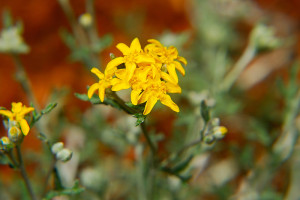
Our native golden yarrow is a good substitute for the buckwheat, and should still provide lots of interest for our pollinators
This plant will provide a slightly richer yellow color than the buckwheat, and will also provide more height.
I also found a few woolly sunflower plants (Eriophyllum lanatum) that will be planted in a nearby bed, to drag more of this similar yellow throughout the front garden area.

Woolly Sunflower (Eriophyllum lanatum) is a related species, with slightly larger, but equally vivid yellow blooms
Both species of Eriophyllum should fill in well, providing blooms through at least midsummer, and their silvery grey foliage will be a nice contrast in color to the darker greens of the Ceanothus, and Arctostaphylos.
Speaking of Ceanothus, another substitution was Ceanothus ‘Puget Blue’, for ‘Wheeler Canyon’. We had our doubts about the deer resistance of ‘Wheeler Canyon’ when we put the plan together.
I planted ‘Wheeler Canyon’, but two days later the deer had already tip-pruned it, and a mole that wasn’t looking where he was going succeeded in pushing one plant completely out of the ground. I selected some larger 5 gallon Ceanothus ‘Puget Blue’ to plant in its place. I rarely purchase plants that large, in part because I hate digging holes that big, but I’m hoping their slightly larger size will give them a better start, and make it less likely that moles can just pop them out of the soil.
Thus far the deer seem to be mostly leaving the plants alone. The ‘Puget Blue’ hasn’t been touched, and reportedly this cultivar is as deer resistant as Ceanothus gets.
However, one of the showy milkweed (Asclepias speciosa) plants, that I had propagated in the greenhouse, was ripped from the soil by a curious doe.
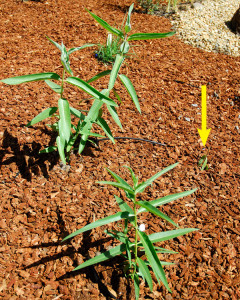
This is all that remains of a 2 foot tall Asclepias Speciosa (yellow arrow). The deer were supposed to ignore this plant!
I’ve temporarily positioned our portable electric fence around the garden. As the fence failed to work for the chickens, we’re hoping it will at least manage to keep a few plants safe while they establish their new root systems.

The deer didn't eat it though, so I've salvaged the top of the plant, and am attempting to root cuttings in the greenhouse
I suspect once the Asclepias grows a little larger, these plants will be too bitter for the deer to want to sample. At least I hope so! Fortunately, the narrow-leaved milkweed (Asclepias fascicularis) that I planted nearby, was untouched.
That’s the problem when you create a habitat garden…the wildlife…including the deer, feel compelled to investigate!
It’s not all bad though, and it’s quite clear that other creatures are enjoying our redesign of this area. The old deck that was once there didn’t provide much interest for bumble bees…
Or the lizards…
The honey bees are regularly seen foraging for water around the fountain, and this water source will now be available to them year around.
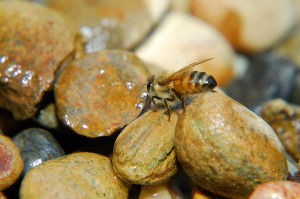
Honey bees need a reliable water source during the dry season, which they use to help regulate the temperature of their hives
We’ve even seen hummingbirds sipping water from the top of the fountain rock.
Of course, I never see the hummingbirds at the fountain when I have my camera!
It turns out, even the electric fence is of interest…at least to the caterpillars.
What was once an area of sinking earth, beneath an oversized deck, is hopefully now going to become a much more interesting, and attractive, habitat garden.
Of course, it looks a little sparse at the moment.
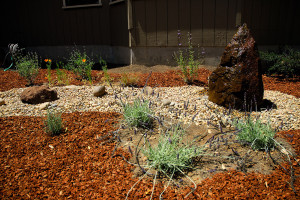
The After: Once the grasses and sages fill in, the garden will look a lot less empty. It's difficult resisting the urge to over-plant!
I suspect that even by summer’s end though, the plants will have filled in considerably.
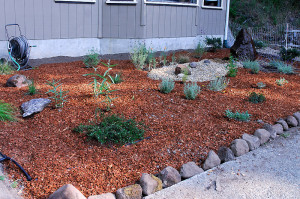
The new garden is done! (Ignore the row of small rocks in front, those are temporary until the new curb is poured for the driveway)
We’ll have to check in from time to time and see how this area grows. In the meantime, I have two more garden beds to finish planting and mulching!
This area though, I’ve barely started on…
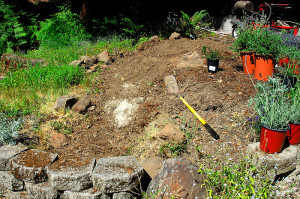
This bed is in front of the one shown above, and mostly full of old flag stone, and rock. Hopefully I can plant this bed out over the weekend, but first...more rocks need to be dug out
…and it needs a LOT of work! But we’re looking forward to seeing this area grow over the next few seasons, and looking forward to seeing many more bees, butterflies, and birds, in this part of the garden too.


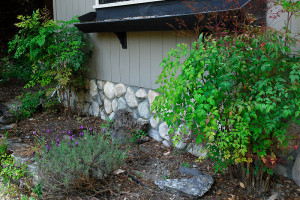

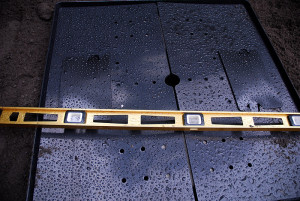
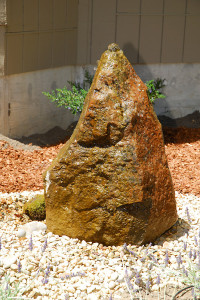


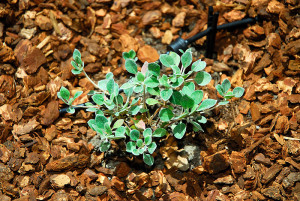



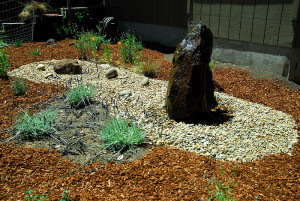
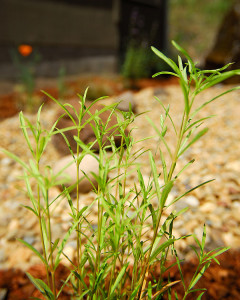
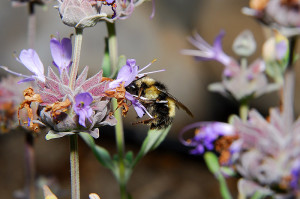
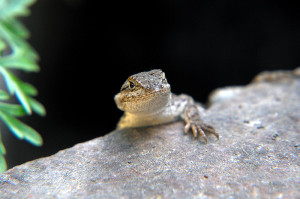
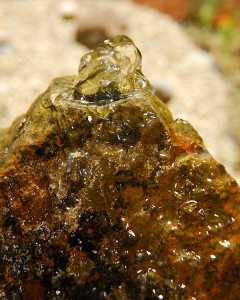
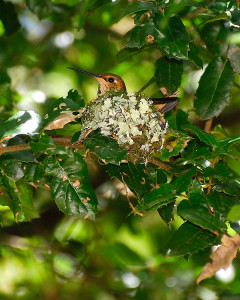
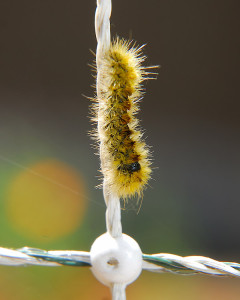

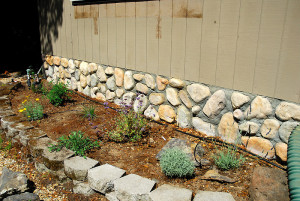







That sounds like the usual mushroom project – starting with one bed and ending up with three! But it really looks great, you will enjoy this when it grows in.
BTW, the CNPS nursery at Hidden Villa had Shasta Sulfur when I went there last Wednesday, probably 15 4 inch pots. I case you want them for next year…They’re open Wednesdays noon-3 until the end of May.
I didn’t intend to do all three beds at once, but it did seem easier to buy all the plants at the same time 😉 Thanks for the lead on the Hidden Villa nursery, I haven’t been up there, so it would be interesting to see what they have.
I love your new native plant garden! What fun that the lizards have already found it. I sympathize about the nandina. I worked so hard to rid my woodland garden of it. This spring I found myriads of tiny nandina seedlings popping up. Fortunately, they were easier to dispose of than their parents.
The lizards were hilarious. The minute we brought the Lodi Stone in they were zipping about. We’ve seen a lot of Skinks too, but those little reptiles are fast, and I never seem to be able to photograph them!
If I never see Nandina again, I’ll be happy. I remember in our last neighborhood it was one of the ‘builder’s special’ plants that was put in at least half of the front yards. I can’t imagine how those gardens look now. I’ve been pulling runners out of that bed all week, and I’m sure a few will still try to pop up from time to time.
I love this post. I’m looking forward to seeing life bloom in your native gardens.
I’m really looking forward to seeing this area next spring, when it’s in bloom, and has filled in. Hopefully by then we’ll see a lot more birds and pollinators too!
Your wildflower bed looks amazing! I love the rock fountain. I thought milkweed was toxic….maybe it only makes the monarch caterpillars toxic to other animals? I just added the thin leaf milkweed to my garden this year.
Milkweeds do contain toxins, but as toxic plants go, the toxins are relatively mild. The deer would have consume large quantities to cause any adverse effect (sheep I think are more sensitive). Regardless though, I’ve always thought the milky sap in these plants was supposed to be unpalatable. They are young plants though, so hopefully once they get a bit bigger, they won’t be so tasty 😉
Clare I also have problems finding local sources for some natives. As always I adore hearing about your natives which are so different then mine. They are so beautiful. I also have problems with critters who must come, see and taste new plants. The fountain is gorgeous and I cannot wait to see the garden in bloom.
I think my problem was time of year. We’re fortunate in that we have so many native nurseries near us. If I hadn’t been so busy with the goats this spring, I would have propagated my own! 😉
Loved hearing about your new beds! I really like your water feature, and the rocks are fabulous – and all the lizards, too! I’ve always loved the look of window boxes, but have often wondered about whether they would cause damage. Now I know the answer. I hope you find the Buckwheat you’re looking for – and that the deer quit sampling the new plants! The before and after is amazing!
I’m happy the deer are leaving everything else alone. I usually leave the pots with the plants still in them, in position, for at least a few days before I start planting. That way if they get browsed, I can move them without having to dig them up 😉 Although I’m already going to have to swap out the Ceanothus again, but that’s for a different reason.
Our bees use the water lily leaves to drink from the pond.
I expect the leaves make really good platforms in the water for the bees. They just need somewhere to stand where they can’t fall in. I’ve seen them here both on this fountain rock, and on the pebbles below. Part of why we chose this rock is it has little areas that jut out, and stay relative dry, giving the insects a good place to stand while they sip.
Hi Clare,
Lovely new garden, and I look forward to seeing it when it’s more mature 🙂
I love how you find it seemingly so easy to source native plants. Here, most of the time I have difficulty finding true natives beyond the basics of Foxgloves and Bluebells. Other butterfly larval foodplants such as trefoils are often difficult to get!
Also, I love your water feature; it makes a nice change from the twee naked lady statues! heehee. I’d love a pond or similar, but with the garden being on tiers I just don’t know where I could have one 🙁
No formal statues here, they just wouldn’t fit with the surroundings. The rock was a bit of an impulse buy, but I already had a rough plan in my head of this garden bed, and just seemed like a perfect fit for the relaxed look we were going for. The basin that holds the water is only 3ft by 3ft, so it can fit in a fairly tight space, we just chose to extend the gravel for looks…and of course…for the lizards 😉
i have some very nice Shasta Sulfurs at the moment. i had a LOT of them last week, but sold quite a few already. i’ve got a few left though. i also carry a huge variety of native plants at my appointment only nursery in oakland. it’s easy to make an appointment to go there and i can make all the recommendations you could ever want if you tell me a little about your site. one observation on your installation above: the puget sounds look very close together. do they have the space they need to reach maturity? otherwise, they won’t grow very well.
Thanks Pete. I actually managed to reserve some Shasta Sulfur with a local Native Nursery, that should be available in a week or two. I’m actually glad I picked up the Eriophyllum too though, as it brings a little more diversity into that bed.
I realized about the Puget Blue’s yesterday when we were mapping out the last large bed. I’d been so hung up on the deer resistance and height of the plants, I’d forgotten to recheck the width of this cultivar. Although some sources suggest only 4 feet in width, more realistically, it looks like 10 feet wide at maturity. It’s not a problem though. Wheeler Canyon would have been ideal for this spot, but with the deer, I think a single ‘Dark Star’ in this spot would be more appropriate. It’s unfortunate the most deer resistant tend to be the larger cultivars. I had tried to find Ceanothus impressus ‘Vandenberg’ to replace Wheeler, but that cultivar wasn’t in production. I’ll be moving one of these Pugets out to the last bed instead, as it’s much wider, and the surrounding edge of the woodland too, further from the house where they can all expand to their full size. That’s what I love about gardening, if it’s not right…you can fix it!
Mole that wasn’t looking where it was going…
*chuckle* 🙂
Your flower bed looks even bigger now compared to when you first started the work – and typical isn’t it – one job leads to another and then another. I’m sure it’s exciting for you seeing your front transform into a wildlife haven after all the problems you’ve had in that area. Nandina is something we yearn to grow here in Perthshire LOL.
I really like the rock bed around the fountain, great idea. Isn’t it funny how one project always seem to end up multiplying into 2 or 3 things?
It’s going to be so beautiful! I love the idea of the rock fountain.
You are doing such a wonderful job replacing the existing gardens with natives. They will be so beautiful when they fill in and your hard work pays off.
I usually cover new plants with a tent of sticks, a wire basket or tomato cage to discourage deer browsing.
Absolutely stunning! I love what you’ve done here and the way you’ve transformed the area!
Very exciting. Makes me miss my garden. I really like that water feature. I’ve never seen anything like it. And I always love how the insects seem to move in almost immediately when you plant interesting things. Though it may look bare now, it will keep you from having to edit out a lot of stuff in the future when it all grows in. Always a better decision.